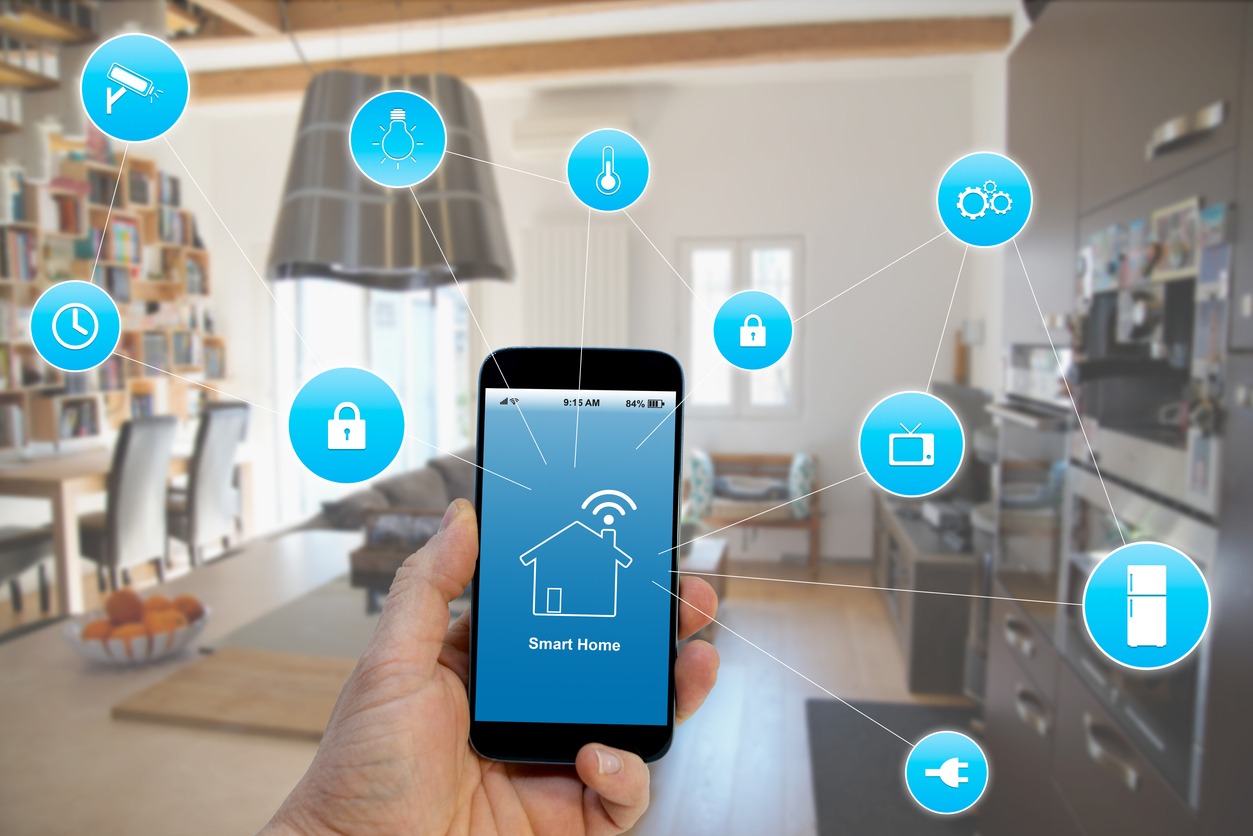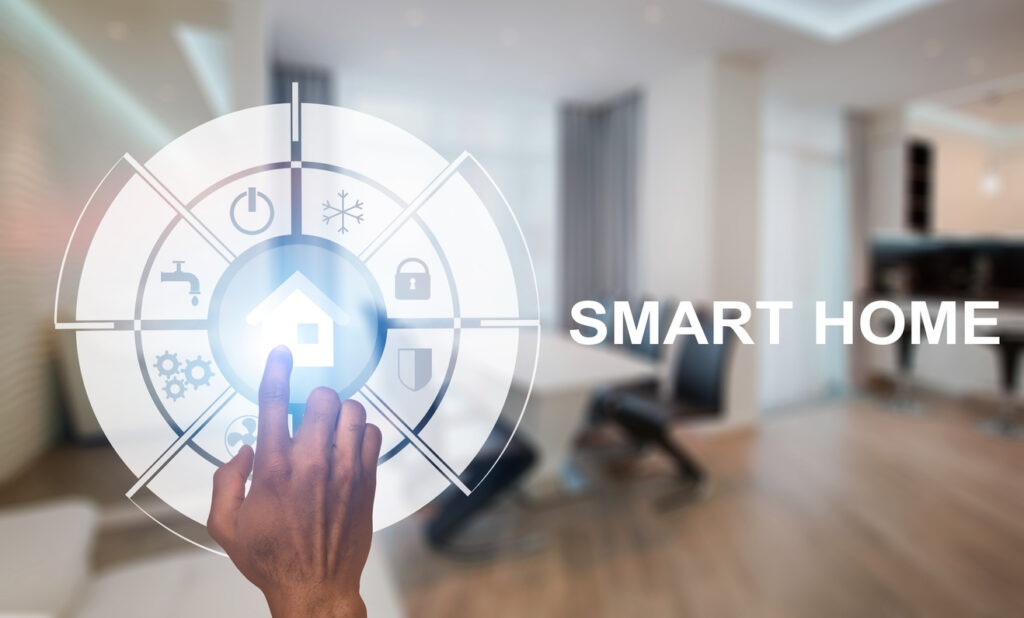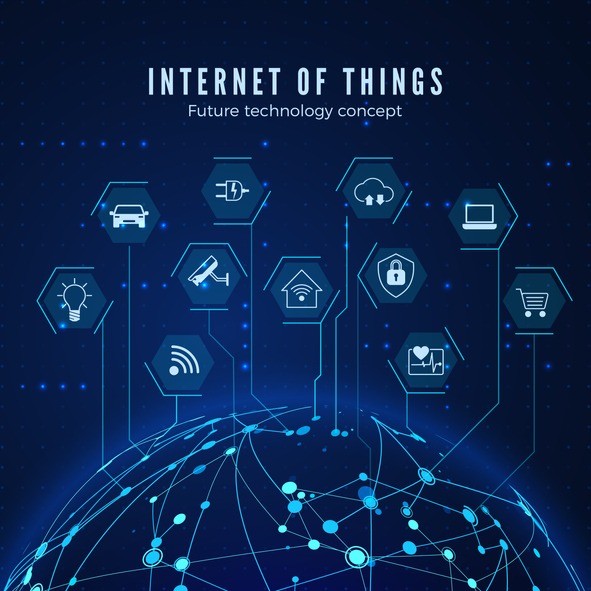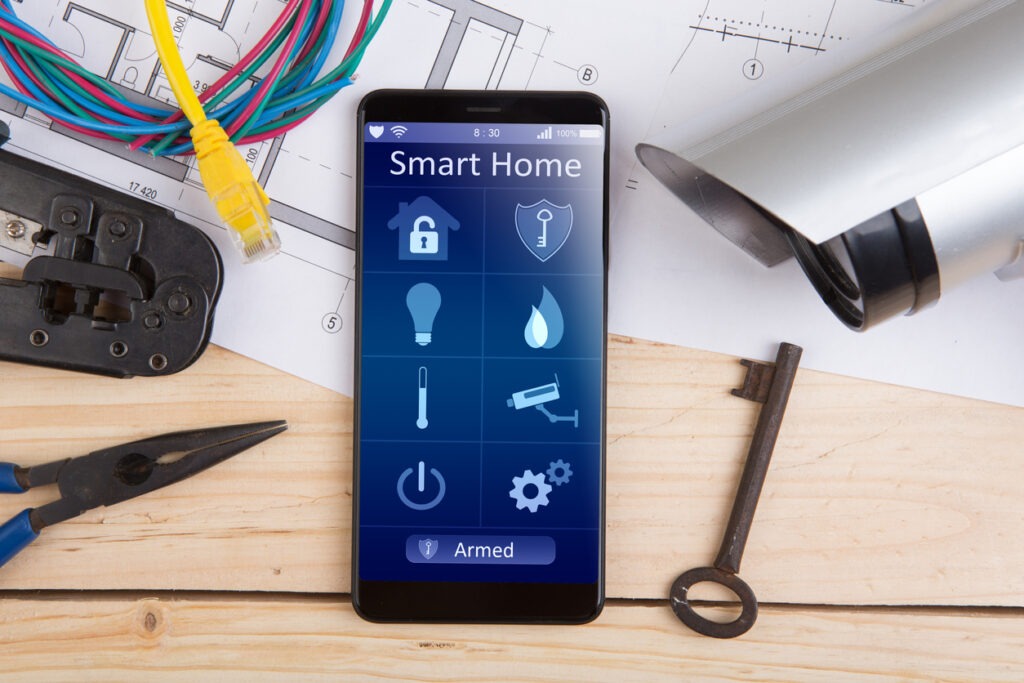A smart home is a residence that employs internet-connected gadgets to provide remote monitoring and control of appliances and systems, such as lighting and heating.
Smart home technology, sometimes referred to as home automation or domotics (from the Latin “domus” meaning home), provides homeowners with protection, comfort, convenience, and energy efficiency by allowing them to operate smart equipment via a smartphone app or other networked device. As part of the internet of things (IoT), smart home systems and devices frequently share consumer usage data and automate activities based on the preferences of the homeowners.
The Beginnings of Smart Homes
With the 1975 release of X10, a communication protocol for home automation, the once-fanciful concept of the “smart home” became a reality. X10 transmits 120 kHz radio frequency (RF) bursts of digital information to programmable outlets or switches via a home’s existing electrical wiring. These signals govern how and when devices operate by communicating commands to their corresponding components. A transmitter may, for instance, send a signal through a home’s electrical wiring to instruct a device to switch on at a certain time.
Due to the fact that electrical wiring is not meant to be free of radio-band “noise,” X10 was not always completely dependable. When 220-volt service is split into a pair of 100-volt feeds, which is commonplace in the United States, signals would be lost and, in certain situations, wouldn’t traverse circuits that were wired on separate polarities. In addition, X10 was originally a one-way technology, meaning that while smart devices can receive commands, they cannot send data back to a central network. Eventually, though, two-way X10 devices became available, albeit at a premium price.
In 2005, when the home automation startup Insteon first appeared on the scene, it introduced technology that merged wired and wireless communications. Other protocols, such as Zigbee and Z-Wave, have since arisen to combat X10’s inherent flaws, although X10 is still a widely deployed communications technology.
Nest Labs was established in 2010 and its first intelligent product, the Nest Learning Thermostat, was released in 2011. Additionally, the company developed intelligent smoke/carbon monoxide detectors and security cameras. In 2015, after being acquired by Google, the company became a subsidiary of Alphabet Inc.
In 2012, SmartThings Inc. launched a Kickstarter effort to fund its smart home technology, raising $1.2 million. The company went public in August 2013 after receiving further finance and was acquired by Samsung in 2014.
Amazon, Apple, and Google have introduced their own smart home products and domotics platforms, such as Amazon Echo, Apple HomeKit, and Google Home, in recent years.
Example of Smart Home Technology
Nearly every part of domestic life where technology has invaded (lightbulbs, dishwashers, etc.) has a smart home alternative:
Smart TVs link to the internet to access content via applications, including movies and music on demand. Some smart televisions have speech and gesture recognition.
In addition to being able to be remotely controlled and altered, smart lighting systems, such as Hue from Philips Lighting Holding B.V., can detect when people are present and adjust the lighting accordingly. Smart lightbulbs can also adjust themselves based on the availability of daylight.
Smart thermostats with integrated Wi-Fi, such as Nest from Nest Labs Inc., allow users to schedule, monitor, and remotely regulate home temperatures. In addition to learning homeowners’ habits, these gadgets automatically adjust settings to maximize comfort and efficiency. Smart thermostats may record energy consumption and remind users to replace filters, among other features.
Users can allow or restrict entrance to visitors using smart locks and garage door openers. Smart locks may recognize when residents are nearby and unlock doors automatically.
Residents may watch their properties whether they are abroad or on vacation using smart security cameras. Smart motion sensors can distinguish between inhabitants, guests, pets, and intruders, and can alert authorities if unusual behavior is observed.
Connected feeders allow pet care to be automated. Utilizing connected timers, houseplants and lawns may be watered.
There are a variety of kitchen appliances available, including smart coffee makers that can brew a fresh cup at a predetermined time; smart refrigerators that keep track of expiration dates, make shopping lists, and even create recipes based on the ingredients on hand; slow cookers and toasters; and washing machines and dryers in the laundry room.
Monitors of household systems may, for instance, detect an electrical surge and turn off appliances, or detect water failures or frozen pipes and turn off the water so that the basement does not flood.
Smart Home Connections
There are several ways for IoT devices to connect to the Internet, with Wi-Fi being the most prevalent. Smart security cameras and systems often employ cellular backup and landline backup, whereas Z-Wave, ZigBee, and Bluetooth are less prevalent.
Wi-Fi
Wi-Fi is a wireless technology that enables IoT devices to connect to the internet at lightning-fast speeds. Using radiofrequency technology, the majority of linked devices connect to your app via Wi-Fi. However, if it’s a crucial device, such as a security motion sensor, you may want to add cellular or landline backup in case the WiFi fails, as we detail more below.
Utilize QR Codes
One of the main applications of QR codes in a smart home is for device control and automation. By placing QR codes strategically around the house, homeowners and residents can easily scan them to trigger specific actions. For example, scanning a QR code near the entrance could automatically unlock the door, disable the security system, and adjust the lighting and temperature to preset preferences. Similarly, a QR code in the bedroom could activate a sleep mode that adjusts the blinds, turns off unnecessary devices, and sets a calming ambiance.
Bluetooth
Bluetooth is used to link your Air Pods or smart speaker to your car’s radio via Bluetooth. Bluetooth is a wireless technology that operates via short-wavelength radio waves. It is utilized most frequently in automobile entertainment systems, hands-free headsets, mice, keyboards, printers, and gaming consoles, and less frequently in smart home security.
Z-Wave
Z-Wave is the name of a wireless communications system that uses low-energy radio waves to allow devices to communicate with one another and the app. In 2019, over 26,000 products were Z-Wave compatible, making it an increasingly popular connectivity option.
Zigbee
Zigbee is another communication system that utilizes digital radios to establish networks. Zigbee is less expensive than Wi-Fi and Bluetooth since it just requires a short-range data transfer, requiring less power. In addition, privacy-conscious users will be pleased to learn that Zigbee is one of the more secure solutions available, as all of its networks are symmetrically encrypted.
Cellular Backup
Why can’t your security system use data like your phone? Some security businesses offer cellular data as a backup in case of a power outage in order to keep everything running. Typically, this service incurs a monthly or annual charge, although it may also be incorporated into the alarm panel or base station via a cellular communicator.
Landline Backup
If you still have a landline in your home, landline backup, which is connected to communication wires or cables, is another technique to keep your system running during a power outage. The major advantage of landline backup over cellular backup is that if you phone the police, they will know your location immediately, but mobile devices’ GPS is not always accurate. Even though they may seem redundant in this day of smartphones, a landline is an excellent way to increase the security of your home.
Smart Home Benefits
Smart homes could make living simpler and more convenient. Who wouldn’t like the ability to control lights, entertainment, and temperature from the comfort of their couch? Whether you’re at work or on vacation, the smart home will notify you of what’s happening, and security systems can be designed to be of tremendous assistance in the event of an emergency. For instance, a person would not only be awoken by a fire alarm, but the smart home would also unlock doors, phone the fire brigade, and illuminate the road to safety.
Here are some further examples of amazing smart home features:
- Illuminate the walk to the bathroom at night.
- automatically unlock your door as you approach.
- Feed your pets according to a predetermined timetable and amount of food.
- Create mood lighting instantly for any event.
- Program your television so that youngsters can only watch it during specific hours.
- Before getting out of bed, warm the bedroom so that it is toasty when you emerge.
- Start the coffeemaker from your bed.
Additionally, smart houses give some energy savings. Because systems such as Z-Wave and ZigBee limit the functioning of particular devices, they are able to go to sleep and wake up in response to commands. When lights are automatically turned off in vacant rooms and rooms are heated or cooled based on who is present at any one time, electric expenses are reduced. Some gadgets can monitor the amount of energy consumed by each appliance and tell energy hogs to use less.
The benefits of smart home technology for elderly individuals living alone are immense.
A smart house may remind the resident to take medication, inform the hospital if the resident falls, and monitor the resident’s food intake. The smart house might handle activities such as cutting off the water to prevent a bathtub overflow or turning off the oven if the cook has gone out. Additionally, it enables adult children who reside elsewhere to engage in the care of their aging parent. Those with disabilities or a limited range of motion might receive comparable benefits from simple-to-use automated solutions.
Smart Home Challenges
Those who are unfamiliar with computers may find the concept of a smart home to be terrifying. Those who often struggle with a remote control to change the television channel may have already stopped reading.
One of the most difficult aspects of building a smart home system is matching the system’s complexity with its usability. If it is truly irritating, then it is making your life more difficult, not easier. When designing the system, it is essential to consider the following factors:
Which types of components make up the system?
- Are they simple, such as a light dimmer, or more substantial, such as an alarm system or a video camera?
- How user-friendly will the system be for a novice?
- Does the device genuinely fulfill a need, or is it only an aesthetically pleasing and potentially irritating toy?
- How many users will be needed to operate the system?
- Who will be capable of operating the system? Who will be able to maintain and troubleshoot the system?
- How simple is it to modify the interface?
- For instance, if your home is scheduled to wake you up at 7 a.m., how will you let it know if you’re out of town overnight for work or sleeping in on a Saturday?
How to Build a Smart Home?
Heating
Smart home technologies now provide better control over heating equipment, including the ability to turn them on, off, and control their operation. Smart products may be equipped with temperature or humidity sensors to turn on or off automatically when particular conditions are reached. This collection of smart home developments includes air conditioners.
Lighting
Lighting devices today expand the capabilities of homes, frequently through the use of a mobile phone, table, or remote designed specifically for a product. The lights can be turned on and off, arranged on a schedule, or programmed to change according to sunrise and sunset periods. Similar to some conventional items, lights can frequently be programmed to respond to motion. Smart light bulbs may communicate over Wi-Fi and display data on your smartphone.
This category may also include smart home lighting products that control or block light. Automatic blinds can be placed and programmed to close at sunrise. Alternatively, electronic curtains enable users to control their blinds via a portable device.
Audio/Visual
Numerous entertainment gadgets are now interconnected and can be managed with a single remote, which is one of the more entertaining features of smart homes. Televisions and loudspeakers can now be played on command utilizing programs, such as by maintaining a timetable or by voice command.
Security
Among the most practical features of a smart home is the enhanced security features. Numerous products now feature cameras that can track motion, record video, or provide live video streams. This can be synchronized with a doorbell or programmed to display in specific sections of your property. These videos may enable video- and audio-enabled video calls with the individual at your door.
Many smart homes also feature updated security systems. This includes motion sensor detectors, house monitoring, warnings and alerts of suspicious conduct, and the ability to lock doors and windows remotely via a phone.
To sum up
Utilizing creativity and technology, smart homes simplify daily tasks. Smart homes have altered the way consumers do things, consume energy, and interact with home devices. This includes the ability to manage programs using a smartphone and schedule products to complete chores at specific times.



